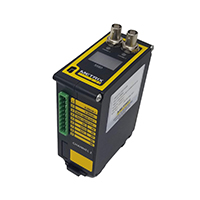Seismic Signal Conditioners
Signal conditioning is crucial in vibration monitoring, preparing signals for integration with other systems or devices. While some conditioners focus on basic functions, others offer advanced processing capabilities, enhancing vibration analysis effectiveness. With machinery vibration monitoring, these devices ensure accurate data collection and interpretation, enabling precise performance measurement and early issue detection.
What Are Seismic Signal Conditioners?
Seismic signal conditioners are specialized devices in vibration monitoring systems. They accept input from and power seismic sensors, converting raw signals into proportional 4-20mA DC signals, they also can extend the dynamic signal for possible input into a vibration monitoring system. Depending upon the signal content, it can extend the signal using a unity gain amplifier an additional 300 to 600 meters. Past 300 meters, the high frequency content greater than 2,000 Hz will be naturally attenuated due to impedance of the long cable length. The 4-20 mA conditioned signals are compatible with process control instrumentation like PLCs or DCS, enhancing overall monitoring efficiency. Advanced models offer features such as optional displays for easy data interpretation, BNC connectors for accessing dynamic sensor signals, and band pass filtering for improved signal quality.
The Signal Conversion Process
This conversion process, known as a transfer function, transforms input signals into workable 4-20 mA output signals. This is crucial in vibration monitoring, similar to how temperature measurements are converted to electrical signals in other monitoring systems. The goal is to create data that control systems can easily interpret and act upon, enabling more effective machinery analysis. Machinery data from pumps, compressors, fans, motors, turbines and other rotating machinery, when correlated with process information, creates a very powerful picture of how the machine is operating.
Metrix Vibration Monitoring Solutions
Metrix offers a comprehensive field configurable seismic signal conditioner for industrial machinery monitoring applications. Our versatile product is compatible with both acceleration and velocity sensors, catering to diverse vibration monitoring needs. Customers can choose the configuration of the signal conditioner they need. It includes an integral display and up to two channels of vibration measurement. The field configurability allows for flexible installation and easy data interpretation in various industrial environments.
How Signal Conditioners Work in Vibration Monitoring
Signal conditioners are essential components in vibration monitoring systems, optimizing data quality and reliability for accurate machinery analysis. By managing machine vibration, one can improve the long-term performance of pumps, compressors, fans, motors, turbines and other rotating machinery. The various types of signal conditioners work to provide different functions:
- Filtering - A filter can be created with either passive or active parts. The architecture of a filter may be either digital or analog. Filters will remove noise or information that is unwanted in a signal. Metrix uses bandpass filters that allow only the frequencies of interests to be observed.
- Amplification - A unity gain amplifier is used to increase the power of the dynamic signal so it can be sent further downline without distortion, up to 300 meters and, if only low-frequency content is needed, it can be extended up to 600 meters.
- Excitation - Metrix Signal Conditioners are powered by 24 Vdc power supply. The Signal Conditioners provide power to the seismic sensors.
- Isolation - Metrix Signal Conditioners protect monitoring devices from high DC levels and filter out interference, maintaining data integrity for precise machinery evaluation.
These functions work together to ensure accurate capture, processing, and transmission of vibration data, enabling effective predictive maintenance and performance optimization in various industrial applications.

Metrix 5580 Smart Signal Conditioner
This signal conditioner can accept signals from machine casing-mounted velocity sensors, accelerometers, or shaft-observing proximity probe systems. It produces a 4-20 mA output proportional to the measured variable to amplify signals. This Smart Vibration Signal Conditioner features two independent channels and a scale output function that can be selected for various units (e.g., RMS, peak, or peak-to-peak if a proximity sensor is used).
When using a proximity probe system as an input, the 5580 Smart Vibration Signal Conditioner can output peak to peak vibration, thrust position, and or speed. The 5580 can be configured with the free Metrix software for a variety of scale ranges.
The 5580 comes with a BNC to access the raw signal and LEDs for sensor status. The display can be used to read both the engineering units and mA for each channel. It can be applied to various items, including generators, turbines, reciprocating compressors, industrial fans, centrifuges, natural gas/diesel engines, motors, and pumps.
Trust Metrix For Your Signal Conditioning Needs
For data acquisition systems, signal conditioners are a crucial facet. Metrix Vibration is a leading supplier of seismic signal conditioners. We offer a full range of products to serve a variety of industries and needs, and we have an online store available for your convenience. If you have questions about seismic signal conditioners, contact the experts at Metrix Vibration.
